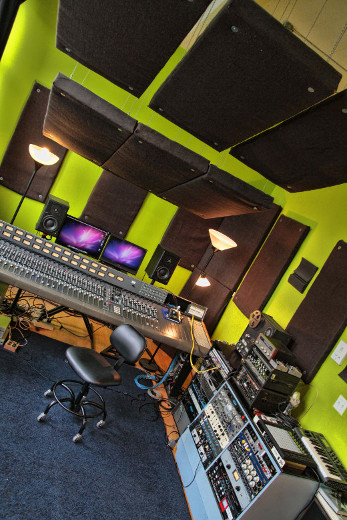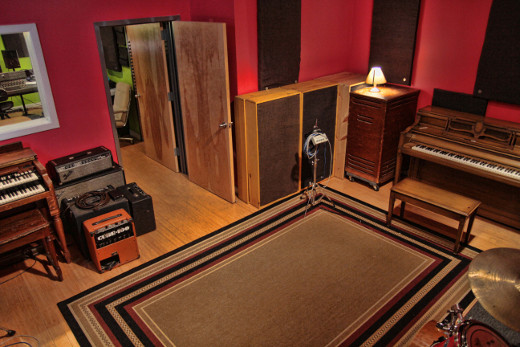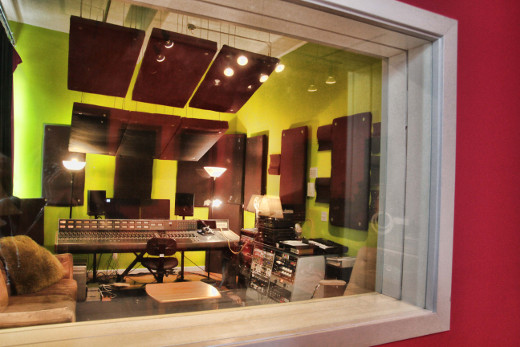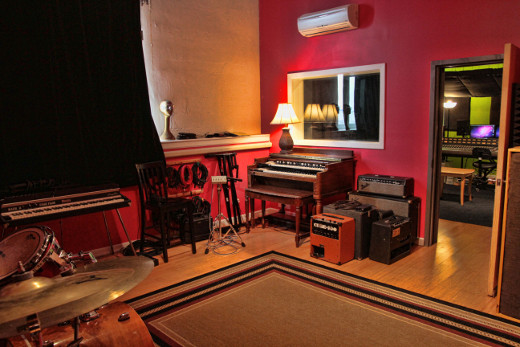Rolling with Two Rooms: Galaxy Smith Studios
How do you go from home studio to a flourishing indie facility, in the thick of New York City?
There are a lot of ways to answer that question, but one approach can be seen in the expanding universe of Galaxy Smith. There’s a lot going on at this two room facility in Brooklyn’s Greenpoint neighborhood, the result of all the right things coming together: committed engineers, smart gear, a well-treated space, and a very welcoming vibe.
Originally founded by Dave Brandwein in 2007, Galaxy Smith’s start was as a bohemian Boston music collective, which coalesced as he studied engineering, music business and guitar at Berklee College of Music. As so many people do, however, Brandwein moved to NYC with the goal of building a more commercial space to record and mix in. “I went back to the basics,” he said. “And focused more on the room, the gear, and finding new people to work with.”
In 2010, Brandwein at the Greenpoint creative hotspot that is 231 Norman, a building practically bursting at the seams with music studios, video production companies, photographers, and all those other creative types that your mother warned you about. Today, he’s partnered with engineer Jim Bertini, who cut his teeth interning and then assisting at The Clubhouse studio upstate. Filling out the team is Dani Barbieri, who serves as the studios in-house photographer, videographer and filmmaker, bringing creative and affordable HD video production services to artists both in and out of the studio.
Targeting the Client Base
As is often essential, Brandwein started up his NYC studio with a leap of faith, knowing full well that it wouldn’t be easy.
“It definitely was a bit scary building a studio from the ground up in a city like New York with so much competition,” he says. “I’ve always had faith that we’d find our client base in people who share the same priorities and vision for recording that we have, which are affordability, the ease of set up, signal flow, vibe and comfort. So far, it’s definitely been working, and growing each year.
“Obviously being in a space with neighbors (at 231 Norman), we have to build relationships and understand certain boundaries,” he continues. “As time has gone on, we’ve continued to build out the space and develop a system with everybody to avoid any issues. Overall it’s really a symbiotic relationship. Sometimes I’ll make or receive a call in the middle of a session asking for some obscure piece of gear, and 9 times out of 10 you’ll strike gold! We all get along pretty well.”
Enter the control room and a number of things strike you at once, all creating a harmonious balance in the process. First is the visual appeal of the acoustic treatments set against the striking lime green paint job. Second is the console, a Sound Workshop 34C obtained from The Bunker Studio.
“It’s a console from the 80’s with plenty of character,” explains Brandwein. “The EQ’s are particularly aggressive and really nice sounding. Because we have so many great outboard preamps, we still use those for the most part, though the board gives us 32 more when needed. Whether we use the board preamps or not, the sound of everything running through there is really chunky and fat, and it gives a great texture.
“The acoustic treatments are actually quite simple, in a good way. Jim designed and made them himself. They use OC703 fiberglass panels wrapped in burlap which looks great and definitely does the trick. The wall treatments are movable, and we also have a bunch of gobos made of the same thing but with added soundboard inside, and a wood trim which makes them stackable.”
Competitively Equipped
When it comes to tracking, Brandwein prefers to let the sufficiently sized live space, reaching 14 feet high, make the difference in his studio sound. It’s an approach that’s helped Galaxy Smith play host to artists including Zongo Junction, Futurist, the Kickdown, Dopapod, Barkhouse, Hollis Brown, and Great Caesar.
“Being able to manipulate our live room is half of it,” he confirms. “We can make that room sound really huge, or really tiny depending on how we treat it and mic it for each session. It’s got a real signature sound to it either way, which helps us shape our recordings.
“It also definitely helps having great digital tools to work with — ProTools HD, top of the line plug-ins, and a great clock and converters — as well as great analog equipment in our console, (Otari MX-5050) tape machine, Space Echo, compressors, preamps and vintage instruments. We really can slide around the vintage to modern spectrum as we please, which keeps a lot of doors open at all times.”
As you can see, the Galaxy Smith crew enjoys a varied diet when it comes to their clients. “Obviously it depends on the project and the vibe that it calls for. It’s always exciting for us to work on something that calls for an older sound. In that case we’ll use more minimal miking techniques, and avoid any digital EQ’s or compression when possible. We love pushing our preamps hard and getting some analog distortion, even taking it to extremes at times which can be really fun. In the most extreme case, we’d bypass Pro Tools altogether and record to tape through the console.”
On call are preamps like the Avalon VT-737 (with EQ and compression), Focusrite VoiceMaster Pro, Black Lion preamps in the Digi002, Summit 2Ba, Seventh Circle A12 and N72, 2x Seventh Circle C84, Chandler LTD1 w/EQ, Chandler Germanium, 2 AEA TRP (specially designed for ribbon microphones), Lomo dual channel custom vintage mic-pres, and a Brent Averill API 312 vintage pre. Emprical Labs Distressors, DBX and SSL compression, an ADL 1000 tube limiter, Roland Space Echo, and Lexion reverb are ready as well.
Meanwhile, Pro Tools HD oversees software from MCDSP, Waves, SSL, Logic Pro, Ableton Live 9 and beyond. Converters are the Lynx Aurora 16 with Avid HD Native Card, and monitoring comes via Dynaudio BM5A’s and Event tuned Precision 8 performance monitors.
“If someone comes in to record a modern sounding pop tune or something,” says Brandwein, “We’ll use more modern techniques, mix a little more in the box, etc… Most of the time we end up using a combination of both, which I think is usually the right call.”
Leveraging the Live Room
Now getting back to that live room. “In its natural state it’s definitely suited for really big sounds,” states Brandwein. “It’s got 14-foot high ceilings and bamboo floors. It’s easy for us to expand or shrink the ‘size’ of the room with our various treatments and the placement of microphones.
“We can achieve huge drum and guitar sounds with very little effort and when it’s called for, we get roomier sounds for all types of instruments like strings, horns, piano or even bass and vocals. At any given time we can use our gobos and sound treatments to limit the reverberation in the room, and close mic the instrument to create a seemingly smaller space.
“We also like being able to find a middle ground, rather than just shoving an amp or a vocalist in a booth, we can play with distance from microphones on a large scale. The room is always open and customizable depending on what the vision is. We really enjoy and fully utilize the versatility of the space for all styles.”
The microphone selection, which includes Neumann, Sennheiser, Groovetubes, Shure, Rode, Cascade, Copperphone, Heil, Sony, and Beyer, are curated to support that vision further. “We have a lot of omni microphones, which are good for enhancing the atmosphere of a larger space,” Brandwein says. “It’s also nice for picking up a fuller spectrum of frequencies, especially low ones, as the instrument resonates in the room. On the other end of the spectrum, we’ve got great vintage dynamic mics which are good for really close, tight sounds — especially when recording multiple instruments at once in the live room, which we’ve been doing more and more of lately.”
The live room is a kindly biosphere for a wide range of keyboards and amps at the ready. “Many musicians and friends have chosen Galaxy Smith as a home for their amazing gear, which includes: a 1965 Hammond B3 w/ Leslie cabinet, a practically mint condition Fender Rhodes, upright piano, and a great assortment of vintage amplifiers, guitars and drum kits among other things.
“I think no matter what mics or pres you have, the instrument, the space, and the performer are always gonna be the most important thing for a track. So naturally having a great selection of quality instruments and amplifiers gives us and the artist a great head start to an amazing recording.”
Sustaining Organic Growth
After a few years in business, Galaxy Smith has learned to relish certain kinds of projects, while welcoming them all. “We’re open to all type of artists, producers and engineers working in our space, but an optimal client would be someone looking to do full project with us from beginning to end,” he says. “We also do a good amount of specific session work, by the half day, when people just want something like organ, piano, drums, etc. We have a lot of great gear and a room to match so whatever a client’s needs are, we do our best to meet them.
“Because I’m a producer in addition to being an engineer, I’m always most excited to do EPs or full albums from start to finish with artists. I help them plan out and execute the entire process, and we work out a plan that works for them both creatively and financially. I think this is really our specialty, and where we shine as engineers and as a studio.”
Brandwein points to an album he produced in 2012 for the Canadian artist, Rachael Cardiello, as a way to hear his room in action. “The album is called Warm Electric Winter (listen to it here), and I think it really displays the versatility of the studio,” he says. “The process of making the album was really amazing and it comes through in the recordings. Some of the arrangements are quite involved and big sounding, yet the album still feels like an intimate listening experience.
“Also,there are a lot of projects that we’ve done recently which aren’t out yet that we’re really excited about, including my band Turkuaz’s upcoming release. Jim also just did some exciting stuff with Blitz the Ambassador, a Brooklyn-based hip hop artist from Ghana (The Warm Up EP).
“You can always hear what we’ve been up to by checking out galaxysmith.com as well. We like to stay involved with our artists post-release and often invite them back from one of our ‘In the Studio’ videos, which is a one-take, multi-tracked, single camera video of a song.
According to Brandwein, the relationships that the studio has with its engineer/producer clients have all come about organically, surfacing through the partners’ combined network. “Generally speaking, (the ideal producer-client) would be someone who shares our common goals of doing good work, respecting the space/gear, and opening us up to new music and business. Right now we have writer/producer/Ableton Ninja, Erin Barra, who you can find at Galaxy Smith a few times a week and she’s been a great addition to our team.”
Continuing the Musical Community
The boy may have left Boston, but the communal approach to music never left Brandwein. Like any good business owner, he’s thinking ahead to the next phase, while still sticking to his fundamentals.
“I love our workflow as is, but of course we’ll always be looking to expand our gear selection and perfect our process,” Dave Brandwein says. “One day I’d love to expand into a bigger space with multiple live and control rooms. For now we try and just improve as much as possible, and hone our craft one day at a time.
“Eventually I’d really like to keep building upon the community aspect of the studio. Galaxy Smith originally started as a music collective out of a home studio — almost bordering on a digital record label, and we’d like to continue to find ways to serve as a means of exposure and support system for artists we love and believe in.
“I think enhancing that part of what we do will further distinguish us as a studio and as a creative identity. ‘In the Studio’ is just the beginning of finding new ways to feature and generate content for artists.”
— David Weiss
Please note: When you buy products through links on this page, we may earn an affiliate commission.











